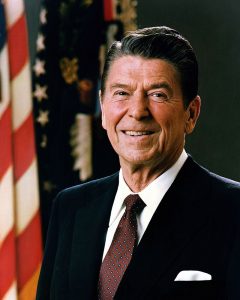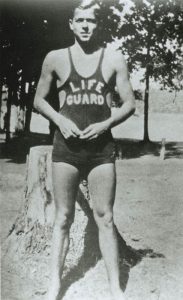 Many people would agree that one of the greatest presidents the United States ever had was Ronald Reagan. He was not what we would consider a career politician, and in fact, most would knw him as an actor long before he was a politician. Nevertheless, after spending time as the President of the Screen Actors’ Guild, where he fought against Communist influence on the screen, Ronald Reagan was elected governor of California in 1966. He then became president in 1980, and the rest, as they say is history, but it is not the end.
Many people would agree that one of the greatest presidents the United States ever had was Ronald Reagan. He was not what we would consider a career politician, and in fact, most would knw him as an actor long before he was a politician. Nevertheless, after spending time as the President of the Screen Actors’ Guild, where he fought against Communist influence on the screen, Ronald Reagan was elected governor of California in 1966. He then became president in 1980, and the rest, as they say is history, but it is not the end.
Ronald Reagan would prove to be a very strong person in many areas of his life…some we know of, and some, maybe not…or at least, I didn’t. After college, where Reagan was an average student, and basically considered a “jack of all trades,” he did some work in radio and such until deciding to enlist in the Army Enlisted Reserve. He was commissioned a second lieutenant in the Officers’ Reserve Corps of the Cavalry on May 25, 1937. On April 18, 1942, Reagan was ordered to active duty, but because of poor eyesight, he was classified for limited service only, which excluded him from serving overseas. His first assignment was at the San Francisco Port of Embarkation at Fort Mason, California, as a liaison officer of the Port and Transportation Office. Upon the approval of the Army Air Forces (AAF), he applied for a transfer from the cavalry to the AAF on May 15, 1942, and was assigned to AAF Public Relations and subsequently to the First Motion Picture Unit (officially, the 18th AAF Base Unit) in Culver City, California. On January 14, 1943, he was promoted to first lieutenant and was sent to the Provisional Task Force Show Unit of “This Is The Army” at Burbank, California. He returned to the First Motion Picture Unit after completing this duty and was promoted to captain on July 22, 1943. While he did not serve in combat, President Reagan was shot. Most of us know that President Reagan survived an assassination attempt on March 30, 1981, when he and his press secretary James Brady were both shot. Also hit by gunfire from would-be assassin John Hinckley Jr outside the Washington Hilton Hotel, were Washington police officer Thomas Delahanty and Secret Service agent Tim McCarthy. President Reagan was “close to death” when he arrived at George Washington University Hospital. He was stabilized in the emergency room, then underwent emergency exploratory surgery. He recovered from his gunshot wound, and was released from the hospital on April 11, becoming the first serving US president to survive being shot in an assassination attempt. President Reagan became very popular after the attempt of his life, with the polls indicating his approval rating to be around 73 percent.
For his part, Reagan believed that God had spared his life so that he “might go on to fulfill a higher purpose.” That is true in my opinion, but it was not the first time Ronald Reagan’s life had been placed at risk. President Reagan attended Dixon High School, where he developed interests in acting, sports, and storytelling, but his first job involved working as a lifeguard at the Rock River in Lowell Park in 1927. He was a life guard there for six years, and during that time, Reagan performed 77 rescues. While much of the rest of his career was highly  public, and well known by most people, this little tidbit was rather hidden in the archives of his life. I suppose many people thought that his job as a lifeguard was a minor role within the many roles he played in his lifetime, but I doubt if the 77 people whose lives he saved as a lifeguard would consider it to be such a minor role. If you have ever been saved from drowning…and I have…you know that you will never forget that person who saved you. I never knew my rescuer’s name, but to this day, I can see her face. I was a girl of about 10 or 12 maybe, and had no training in swimming, but I had achieved the great height of 5 feet, and thought that meant I could swim in the 5 foot area of the pool, not considering that 5 feet was at the top of my head. Thank God for the girl swimming by, who pushed me to the side of the pool. Needless to say, I taught myself to swim after that, and before summer’s end I had passed my swimming test at the pool. What President Reagan did for those 77 people, was as heroic as any soldier. A flailing victim in danger of drowning can take down their would be rescuer, and then both would likely drown. It takes a special person to put their life at risk to save another, and as in many other areas of his life, President Reagan was a true hero.
public, and well known by most people, this little tidbit was rather hidden in the archives of his life. I suppose many people thought that his job as a lifeguard was a minor role within the many roles he played in his lifetime, but I doubt if the 77 people whose lives he saved as a lifeguard would consider it to be such a minor role. If you have ever been saved from drowning…and I have…you know that you will never forget that person who saved you. I never knew my rescuer’s name, but to this day, I can see her face. I was a girl of about 10 or 12 maybe, and had no training in swimming, but I had achieved the great height of 5 feet, and thought that meant I could swim in the 5 foot area of the pool, not considering that 5 feet was at the top of my head. Thank God for the girl swimming by, who pushed me to the side of the pool. Needless to say, I taught myself to swim after that, and before summer’s end I had passed my swimming test at the pool. What President Reagan did for those 77 people, was as heroic as any soldier. A flailing victim in danger of drowning can take down their would be rescuer, and then both would likely drown. It takes a special person to put their life at risk to save another, and as in many other areas of his life, President Reagan was a true hero.


One Response to President Reagan’s First Job